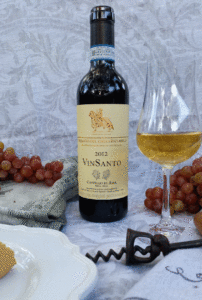 Though the grapes for Vin Santo, a beautiful amber colored dessert wine from Tuscany are picked in September and October they are destined to lie on mats of straw in barns and attics for up to 6 months before they are crushed to make wine. They are kept warm and well ventilated and as the grapes lose moisture, the remaining liquid begins to concentrate the sugars. This is why they are sometimes referred to as “raisin wines”.
Though the grapes for Vin Santo, a beautiful amber colored dessert wine from Tuscany are picked in September and October they are destined to lie on mats of straw in barns and attics for up to 6 months before they are crushed to make wine. They are kept warm and well ventilated and as the grapes lose moisture, the remaining liquid begins to concentrate the sugars. This is why they are sometimes referred to as “raisin wines”.
The length of the drying period is proportional to the sugar concentration, ultimately the alcohol level and general style of the wine. Vin Santo is classified as a dessert wine but is made into various levels of sweetness from bone dry to very sweet, though problems can develop in the extreme ends.
At the end of the drying period, the fruit is crushed and mixed with yeast in addition to a kind of ‘starter yeast’ left over from a prior vintage.
After the fermentation (yielding the desired style) the wine is aged in small barrels, historically of woods other than oak, though in the last few decades, prestige produces are moving exclusively to oak.
By DOC regulations, vin santos are required to age for at least 3 years though it is not uncommon for producers to age their wines for 5 to 10 years.
The 2012 Vinsanto by Castello di Ama is a lovely, complex wine. It’s mildly sweet but has enough acid to not be cloying. Typical of Vin Santo, there were wonderful initial aromas of apricot, dried fruit and honey.
The mouth feel was big with ripe melon flavors and soft pear notes with hints of butterscotch. The wine has a long finish with slight peppery note. All in all, a very pleasant wine to drink. In Italy vin santo is traditionally served with biscotti though it does pair well with aged cheese.
This Castello di Ama is made from 65% Malvasia Bianca and 35% Trebbiano Toscano which were planted in 2010. In some vintages, they will add some Sangeovese yielding a slightly rosé look to the wine.
It has an alcohol content of 14.5%, though not strong, it can be modest for some vin santo. The Castello di Ama is DOC: Vin Santo del Chianti Classico and their wines are typically aged for 5 years in old French barriques from Allier.
Vin santo like other wines made from reduced juice; late harvest, sauternes, ice wines, tend to be expensive. The Castello di Ama is in the $60 range for a half bottle; however, it would be ideal to end fine, romantic Italian meal.
Richard Arebalo
OTL / Features Editor